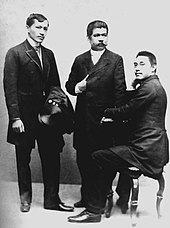Captaincy General of the Philippines
The Captaincy General of the Philippines[a] was an administrative district of the Spanish Empire in Southeast Asia governed by a governor-general as a dependency of the Viceroyalty of New Spain based in Mexico City until Mexican independence when it was transferred directly to Madrid.
For centuries, all the administrative, political and economic aspects of the Captaincy General were administered in Mexico City by the Viceroyalty of New Spain for the Spanish Crown.
After a long, tolling voyage across the Pacific Ocean, Ferdinand Magellan reached the island of Guam on 6 March 1521 and anchored the three ships that were left of his fleet in Umatac Bay, before proceeding to the Philippines, where he met his death during the Battle of Mactan.
Antonio Pigafetta, the expedition's chronicler and one of only 18 original crew members to survive Ferdinand Magellan's circumnavigation of the globe, recorded all details of the voyage.
Later (in 1569), Miguel López de Legazpi transferred the Spanish headquarters from Cebu to Panay, where they found allies, who were never conquered by Spain but were accomplished as vassals by means of pacts, peace treaties, and reciprocal alliances.
[2] On 5 June 1569, Guido de Lavezaris, the royal treasurer in the archipelago, wrote to Philip II reporting about the Portuguese attack on Cebu in the preceding autumn.
In 1584, the Real Audiencia of Manila was established by King Felipe II, who appointed as its president the same governor of the Captaincy General of the Philippines.
As part of the extensive governmental reforms during the early Bourbon period throughout the overseas possessions, an Intendencia was established in Manila by Royal Decree of 17 July 1784 that handled issues regarding the government finances and to promote the economy.
Ciriaco González Carbajal was appointed as Oidor of the Audiencia of Manila and was instructed to abide by the Royal Ordinance of Mayors of 1782, that had been enacted in Rio de la Plata.
Throughout the second half of the 19th century, there were established many dependent local government offices and military settlements, very numerous due to a large number of islands and the extent of the districts.
In times of war, the encomendero was duty bound to provide soldiers for the King, in particular, for the complete defense of the colony from potential invasions of outside powers such as the Dutch, British and Chinese.
The encomienda system was abused by encomenderos and by 1700 was largely replaced by administrative provinces, each headed by an alcalde mayor (provincial governor).
[citation needed] All executive power of the local government stemmed from him and as regal patron, he had the authority to supervise mission work and oversee ecclesiastical appointments.
Alcaldes mayores and corregidores exercised multiple prerogatives as judge, inspector of encomiendas, chief of police, tribute collector, capitan-general of the province, and even vice-regal patron.
In the 19th century, the Peninsulares began to displace the Insulares, which resulted in the political unrests of 1872, notably the 1872 Cavite mutiny and the Gomburza executions.
Among his administrative duties were the preparation of the tribute list (padron), recruitment and distribution of men for draft labor, communal public work and military conscription (quinto), postal clerk and judge in minor civil suits.
Named after its author, Don Antonio Maura, the Spanish Minister of Colonies at the time, the law reorganized town governments in the Philippines with the aim of making them more effective and autonomous.
All sorts of products from China, Japan, Brunei, the Moluccas and even India were sent to Manila to be sold for silver 8-Real coins which came aboard the galleons from Acapulco.
These goods, including silk, porcelain, spices, lacquerware and textile products were then sent to Acapulco and from there to other parts of New Spain, Peru and Europe.
The Galleon trade brought silver from New Spain, which was used to purchase Asian goods such as silk from China, spices from the Moluccas, lacquerware from Japan and Philippine cotton textiles.
[16] However, the trade did result in cultural and commercial exchanges between Asia and the Americas that led to the introduction of new crops and animals to the Philippines such as tomatoes, avocado, guava, papaya, pineapple, and horses.
[19] The first vessel of the Royal Philippine Company to set sail was the "Nuestra Señora de los Placeres" commanded by the captain Juan Antonio Zabaleta.
[22] Aside from paying a tribute, all male Filipinos as well as Chinese immigrants from 16 to 60 years old were obliged to render forced labor called "polo".
In the last quarter of the 19th century, Spain conquered portions of Mindanao and Jolo,[24] and the Moro Muslims in the Sultanate of Sulu formally recognized Spanish sovereignty.
[25][26] During the British occupation of Manila (1762–1764), Diego Silang was appointed by them as governor of Ilocos and after his assassination by fellow Filipinos, his wife Gabriela continued to lead the Ilocanos in the fight against Spanish rule.
A short time later, the Solidaridad grew, and some of its members included José Rizal, Pedro Serrano Laktaw, Baldomero Roxas, and Galicano Apacible.
Rizal's sisters Trinidad and Josefa, Marina Dizon, Romualda Lanuza, Purificación Leyva, and many other women join the Masonic movement.
















